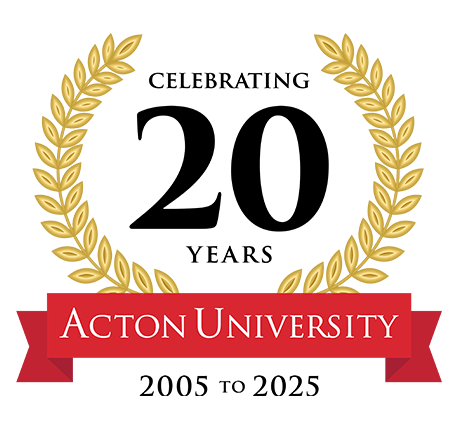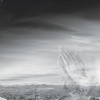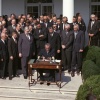In a recent review of Robert P. George’s The Clash of Orthodoxies, Samuel Gregg, Director of the Acton Institute’s Center for Economic Personalism, observed that “we have witnessed something of a renaissance of natural-law thinking among Christian scholars.” Another piece of evidence of this renaissance is The First Grace: Rediscovering the Natural Law in a Post-Christian World by constitutional scholar and natural-law theorist Russell Hittinger.
The First Grace is not only an original but also a challenging contribution to the natural-law discourse. The book is divided into two sections. The first, entitled “Rediscovering the Natural Law,” argues that the modern conception of natural law and natural rights is not only wrong but also profoundly misleading. To correct this, Hittinger attempts to ground the natural-law discourse in its traditional theological environment. The second section, “Natural Law and the Post-Christian World,” presents engaging discussions on controversial present day issues, with specific reference to the United States Constitution, the role of the judiciary, and limited government.
Autonomous Man Versus God and Natural Law
The first part of The First Grace deals with the foundations of natural law. Hittinger argues that the problem of natural law cannot be properly understood without reference to God as the ultimate governor and legislator. In reviewing the history of natural-law discourse, Hittinger shows how the original understanding of natural law as “the ordinance of a divine lawgiver” (4) was supplanted in the modern era by a secular myth of a “state of nature” by Rousseau, Locke, and others. This myth “was meant to be a secular substitute for the story of Genesis” and it was “designed for the political purpose of unseating the traditional doctrine of natural law” (14).
Hittinger points out that the modern conception of natural law eventually came to color the moral theology of the Church. Consequently, the natural-law discourse was silently separated from the doctrine of providence, and in the end it became nothing but a mere “persuasive tool” for moral arguments (16). Such a conception of natural law, coupled with the secularist clamoring for various sorts of alleged “rights,” was bound to lead to fundamental misunderstandings among twentieth century moral theologians.
Why then must the natural law be grounded in God as the ultimate source of that law? Is the light of natural reason not enough for us? Hittinger concedes, as did St. Thomas Aquinas, that “it is by the natural power of reason that we partake of the law” and “the law is instilled or indicted in us so as to be known naturally” (97). This is why St. Thomas called it ‘natural’ law. However, “[o]nce natural law is equated with the human power to make practical judgments, its specifically legal character as a perceived (or participated) law is muted, if not abandoned” (46). This leads to a profound misunderstanding of what natural law is all about. In effect, it opens the way to a vast array of false theories, in particular the idea of natural law as mere “individual autonomy,” as suggested by such figures as the Jesuit priest Joseph Fuchs. Hittinger criticizes this interpretation and points out that the difference between natural law with or without the legislating God is “no more subtle than the difference between giving a teenager the keys to the car with a set of instructions, and just giving him the keys to the car” (24).
As a way out of the present confusion, Hittinger points in particular to John Paul II’s Veritatis Splendor. The goal of the encyclical is precisely to take the discussion back to the theological and anthropological environment, and to show that the foundations of the moral order lie in the relationship between man and God.
Judges, Constitutions, and Limited Government
If the first section of the book requires some background knowledge of the natural-law discourse, the second part is directed especially to those interested in the American legal system. An expert on constitutional law, Hittinger applies the theory of natural law to recent controversies concerning the role of judges, constitutions, and government. He examines in particular the United States Supreme Court’s famous decision in Planned Parenthood v. Casey (1992) and its influence on the American political climate.
In “Natural Law in the Positive Laws,” Hittinger clarifies the much debated question of whether the judiciary should bring judgments of moral and political philosophy to bear in their decisions. Some, such as Judge Robert Bork, have claimed that natural-law theory demands that judges have such rights. Hittinger disagrees. Activist judicial review, in his view, would imply a usurpation of power and contradict the constitutional ideal of the rule of law. Because the precepts of natural justice forbid such a usurpation, “[j]udicial preference for natural law over positive law is a contradiction in terms” (112). Moreover, case law is prone to lead to unsystematic and incoherent judgments, and is therefore unsuitable for promulgating the natural law. In fact, “[o]ur reliance upon the judiciary to speak the natural law in the course of its ordinary obligation to ius dicere … puts a bad face on natural law theory” (84).
The problematic role of the judiciary is further illuminated in the chapter “Natural Rights, Under-Specified Rights, and Bills of Rights.” Hittinger presents not only a criticism of the dubious rights-talk of various political pressure groups, but also a profound and enlightening analysis of what, from a legal point of view, has happened to the American experiment of limited government, and why. The central problem is what he calls “under-specified natural rights,” such as those found in the Bill of Rights. The author’s main interest is the United States Constitution, but he states that similar problems afflict Canada and, increasingly, the European Union.
How could the Bill of Rights create problems for limited government? Hittinger reviews the history of the Constitution and points out that, instead of assigning specific tasks for the central government, the original Constitution was meant to limit its powers once and for all. Already Hamilton warned that adding abstract rights to this would not limit the government any further; instead it “would furnish to men disposed to usurp, a plausible pretense for claiming that power.” That is exactly what has happened. Hittinger explains: “Once government is commissioned to secure the end of generally stated moral desiderata, government will not only claim the power to interpret the scope of these ends, but will also claim power over the means to achieve them .… Everyone believes that they have rights, but no one actually knows what they are until an organ of the government specifies them” (128-9).
The situation has become increasingly murky after the Supreme Court’s decision in Planned Parenthood v. Casey, which stated that “[a]t the heart of liberty is the right to define one’s own concept of existence, of meaning, of the universe, and of the mystery of human life.” This leaves all doors open. According to Hittinger, “[s]o stated, it could mean anything. A right that can mean virtually anything does not limit the government. Rather, such a right authorizes the government both to meddle in social relations for the purpose of securing open-ended claims of justice, and (paradoxically) to make constant exceptions to the alleged right whenever its open-ended character seems to conflict with some compelling governmental function” (129). He concludes: “Until [the right] is further specified, no one can know who is bound to do (or not do) what to whom. And so long as that condition persists, there is no limit to the government” (130).
In the section called “Crisis of Legitimacy,” Hittinger goes further with the Planned Parenthood case. He shows that the decision and its content present serious challenges for the legitimacy of the legal regime. Especially troubling is the Court’s position on its own legitimacy: “The Court’s power lies … in its legitimacy, a product of substance and perception that shows itself in the people’s acceptance of the Judiciary as fit to determine what the Nation’s law means and to declare what it demands.” Hittinger points out that such a position is unprecedented in the whole constitutional history, and he comments: “Were an executive officer to define his power in this fashion, we might suspect it was Mussolini” (203). Hittinger labels the creeping new regime as the “soft despotism of courts,” meaning that “courts … claim to be the final and exclusive voice of the people. Courts tell us when to stop talking and when to obey” (213).
Rediscovering Tradition
Traditionalist natural-law theory has been criticized for “fundamentalism” and trying to “beat listeners over the head with the Bible.” Hittinger’s The First Grace demonstrates that such accusations are seriously misplaced. Regardless of the reader’s religious and political persuasion, Hittinger’s discussions of both practical and theoretical questions are filled with compelling arguments, penetrating judgments, and well-grounded conclusions. The First Grace deserves the attention not only of legal and political theorists but of anyone who cares about the American experiment of limited government and its future.












